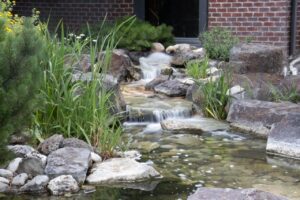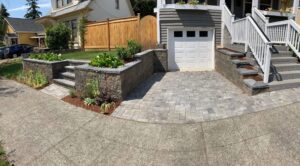Having a beautiful lawn year round can be one of the key features of giving your home the gorgeous street appeal that you want it to have. It is after all the first impression that you make with your friends, family, neighbors, and anyone that comes by your home.
What about having something that makes your home gorgeous that is just for you and your family?
Many homeowners consider adding or building water features on the front of their home, but truth be told, having a water feature in your backyard is equally tranquil. Not only does it give you and your loved ones the perfect sanctuary to unwind and relax, but it also adds a visual and financial boost to your home.
We realize that adding a water feature to your home can be an intimidating process. Based on the backyard waterfalls and ponds that you have seen, you may already realize that this isn’t going to be an overnight install. Which is why we are going to walk you through everything that you need to know about installing a backyard waterfall.
Before you Get Started
Here are a few items that you should take a look at before you get started with construction.
1) Using Your Space
The first and most important thing that you need to decide when you are working on your own backyard waterfall is how you are going to use that space. This decision may be easier for some and more difficult for others, and largely depends on the amount of space that you have in your backyard.
We recommend considering how much of your backyard you need to keep open as functional space. That will make it an easier decision when it comes to configuring the aesthetic space that your backyard waterfall is going to occupy.
2) Low Vs. High Maintenance
The next item that you need to consider is whether you want to have a waterfall that is low or high maintenance. You can get elaborate and decadent with your waterfall as you could possibly imagine, or you could simplify it and make it as easy to take care of as you like.
3) Deciding on your Style
Before you go into digging up space for your backyard waterfall, you should go into the process with a good idea of the look of the waterfall that you want to create. This can include how you want your pond to look, rock placement, and the type of rock that you want to use. What plants or greenery are you going to be including around your waterfall?
Getting Started
1) Outline Your Area
Now that you have a great idea of where your waterfall is going to be, you may want to use some garden hose and/or some paint to outline the area. Make sure that you do not move around the perimeter of your waterfall while you are preparing the area.
2) Determine the Slope or Drop
The larger the drop in your waterfall, the steeper the slope. This is going to require a more powerful pump to return your water back to the top of the waterfall, and pumps can get really expensive. If you are looking to save some time and headache for yourself, you don’t need a lot of slope to make a gorgeous waterfall. A good rule of thumb is that for every 10 feet of stream that you have, include at least two inches of slope.
3) Clear Out Your Space
If your soil is soft and you are able to dig, the first thing that you need to do is dig out the area that you are going to be using for your waterfall. If you live on tougher soil, you may want to consider building your waterfall above ground. Having your waterfall above ground is going to be a little different in that you are going to be using stones for the base of your waterfall.
4) Installing the Liner
After you have dug out the space for your waterfall, you are going to need to add some layers above ground to protect your property and your waterfall. For the first layer above the ground, you are going to want to add a thick layer of landscaping fabric. Next, you are going to need to lay rubber pond liner over that, making sure that there are no splits or breaks in the liner, to prevent leaks in the waterfall and your pond.
5) Install Your Pump and Hose
After you have your liner down, you are ready to set up your pump and hose. During this part of the process, you can use boulders and sturdy rocks around the pump and the hose to secure the key facets of your waterfall, in place.
6) Finish It Up
After that, you are just about all set! You can go ahead and fill up your pond, which is what will give your pump the ability to circulate your waterfall. You can add any additional rocks, gravel, plants and other greenery to your waterfall.
B&D has been landscaping and adding waterfalls to yards for over 30 years. If you are interested in having an experienced landscape contractor help with the installation of your backyard waterfall, contact us for a free quote today and with any questions you may have.



